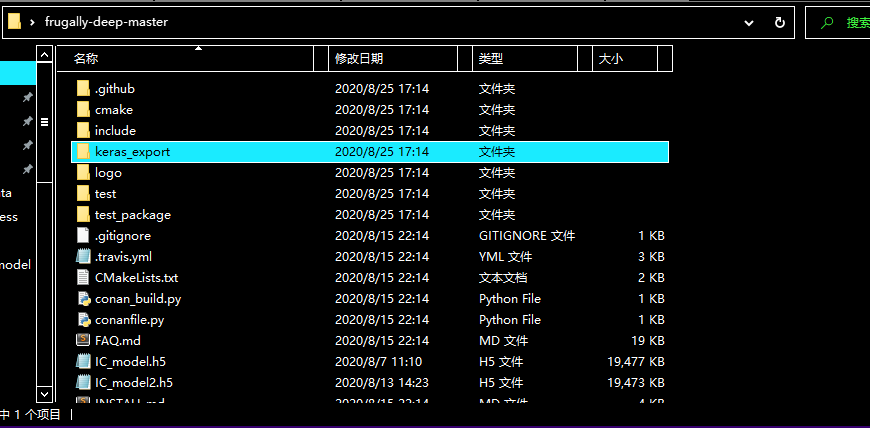近期在做一个涉及到验证码识别的小程序,使用了一万多张图片进行训练,得到了一个几兆的模型,预测模块也写好了,结果用pyinstaller打包后发现居然有400多M(tensorflow-cpu 2.3版)。如此庞大的体积真的使我有了进一步优化的兴趣。随后,我决定将模型+预测代码嵌入c++ dll中。首先的方案肯定是手动编译tensorflow, 然后把keras模型冻结,转为tensorflow的pb模型等等。其实呢这本身算不上多么困难,但是编译tensorflow的坑太多,而且文件体积未必能小到哪里去。于是,经过我在github的一番查找,找到了一个名为“frugally-deep”的库,从它的说明中我得知它可以在没有tensorflow的参与下进行前向传播,也就是预测。这是链接:
frugally-deepgithub.com由于它本身依赖很多库,这里直接给大家配置它的教程,大家只要按照教程走就不会有太多问题:
C++中用frugally-deep读取keras的模型并进行预测(详细)_1037号森林里一段干木头的博客-CSDN博客blog.csdn.net
不过需要注意的是 ,这个教程中提到了opencv,这个库体积也是很大的,它也需要动态链接dll,这显然与我追求更小的文件大小相违背,何况我的需求不需要如此重型的库。事实上,frugally-deep自身不依赖图片库。我在github上找了一个名为spot的库以实现与图片相关的交互功能。
spotgithub.com我的dll中以资源文件的形式嵌入了两个模型,并在dllmain中调用LoadModelResourceToMemory函数将其加载入内存。predict函数用来预测。示例代码如下:
#include "resource.h"
#include <fdeep/fdeep.hpp>
#include <cstdlib>
#include "spot.hpp"
#include <Windows.h>
#include <tlhelp32.h>
#include <tchar.h>
#include <ShellAPI.h>
HINSTANCE hd;
const char a[30] = { '1','2','3','4','5','6','7','8','9',
'a','b','c','d','e','f','h','j','k','m','n','p','r','s','t','u','v','w','x','y','z' };
const char b[10] = { '0','1','2','3','4','5','6','7','8','9' };
int assist_func(const fdeep::tensor& t)
{
const auto xs = *t.as_vector();
int maxcount = 0;
for (int i = 0; i < xs.size(); i++)
{
if (xs[maxcount] < xs[i])
maxcount = i;
}
return maxcount;
}
fdeep::tensor gettensor(const void*img, int len)
{
spot::image simg(img,len);
std::vector<unsigned char> pixels = simg.rgb();
return fdeep::tensor_from_bytes(pixels.data(), simg.h, simg.w, 3,
0.0f, 255.0f);
}
fdeep::tensor gettensor(std::string path)
{
spot::image img(path);
std::vector<unsigned char> pixels = img.rgb();
return fdeep::tensor_from_bytes(pixels.data(), img.h, img.w, 3,
0.0f, 255.0f);
}
struct modeldatapointer
{
std::string model_str1;
std::string model_str2;
bool loadsucc = true;
};
modeldatapointer md;
void LoadModelResourceToMemory()
{
UINT modres1 = IDR_MODEL1, modres2 = IDR_MODEL2;
LPCSTR name1 = MAKEINTRESOURCEA(modres1), name2 = MAKEINTRESOURCEA(modres2);
auto hres1 = FindResourceA(hd, name1, "MODEL"), hres2 = FindResourceA(hd, name2, "MODEL");
HGLOBAL hresdata1, hresdata2;
hresdata1 = LoadResource(hd, hres1);
hresdata2 = LoadResource(hd, hres2);
auto size1 = SizeofResource(hd, hres1);
md.model_str1.resize(size1);
auto size2 = SizeofResource(hd, hres2);
md.model_str2.resize(size2);
char* pres1 = (char*)LockResource(hresdata1);
char* pres2 = (char*)LockResource(hresdata2);
if (!pres1 || !pres2) { FreeResource(hresdata1); FreeResource(hresdata2); md.loadsucc = false; return; }
CopyMemory(&md.model_str1[0], pres1, size1);
CopyMemory(&md.model_str2[0], pres2, size2);
FreeResource(hresdata1); FreeResource(hresdata2);
return;
}
fdeep::model* p_mod1 = nullptr;
fdeep::model* p_mod2 = nullptr;
extern "C" __declspec(dllexport) char* __stdcall predict(const void* img, int len)
{
if (((const char*)(img))[0]!='G')
{
auto input = gettensor(img,len);
const auto pre_class = p_mod1->predict({ input });
char* temp1 = new char[6];
for (int i = 0; i < 5; i++)
temp1[i] = a[assist_func(pre_class[i])];
temp1[5] = '0';
return temp1;
}
else
{
auto input = gettensor(img,len);
const auto pre_class = p_mod2->predict({ input });
char* temp1 = new char[5];
for (int i = 0; i < 4; i++)
temp1[i] = b[assist_func(pre_class[i])];
temp1[4] = '0';
return temp1;
}
}
extern "C" __declspec(dllexport) void __stdcall release(void* p)
{
delete p;
}
BOOL APIENTRY DllMain( HMODULE hModule,
DWORD ul_reason_for_call,
LPVOID lpReserved
)
{
switch (ul_reason_for_call)
{
case DLL_PROCESS_ATTACH:
hd = hModule;
if (!p_mod1)
{
LoadModelResourceToMemory();
static auto model = fdeep::load_model_string(md.model_str1);
static auto model1 = fdeep::load_model_string(md.model_str2);
p_mod1 = &model;
p_mod2 = &model1;
}
break;
case DLL_THREAD_ATTACH:
case DLL_THREAD_DETACH:
case DLL_PROCESS_DETACH:
break;
}
return TRUE;
}
若不算上模型,仅将frgually-deep和spot两个库简单整合,生成的dll仅有1M左右,可以说是小巧玲珑了。在python中与这个dll进行交互也是简单的。我的python代码示例如下:
from ctypes import *
import queue, threading, ctypes, os
class Identify(threading.Thread):
def __init__(self):
self.queue = queue.Queue()
self.queue2 = queue.Queue()
super().__init__()
self.dll = ctypes.windll.LoadLibrary('.predict.dll')
self.dll.predict.restype = c_uint64
self.mod = 0
def run(self):
while True:
r = self.queue.get() #这里r是requests.get()得来的图像字节流。
if r is None:
print('S2:-----------------------sub thread exit')
return
p = self.dll.predict(cast(r.content, c_void_p), c_int(len(r.content)))
r = string_at(p)
self.dll.release(c_int64(p))
self.queue2.put(r)最后经过重新打包,我的程序只有60M,相比原来的400M,空间优化效果显著。不过,我在此介绍的只是简单的分类模型,如果是生成模型,检测模型,目测是不可行的。frugally-deep的readme.md中写出了不支持的网络层类型,可以参考。





















 498
498

 被折叠的 条评论
为什么被折叠?
被折叠的 条评论
为什么被折叠?








